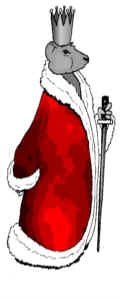

RhythmThis web page contains an active listening lesson for a general music class (grades 7-12). Included in this site is a complete lesson plan and procedures along with a musical excerpt.
This piece is characteristic
of a Russian dance which has a fast moving tempo. The meter of this piece
is 2/4
throughout. Each section is
based on a repetitive rhythm. Rhythmic building blocks consist of eighth
notes, sixteenth
notes, quarter notes, and an
eighth note tied to two sixteenth notes. Theme B uses a different rhythm
than Theme A
but still uses the same building
blocks. Sforzando accents occur on the second beats of many measures throughout
this piece. This piece is extremely
fast and energetic.
Melody
The melody is written in a major
key and although it is fast, it is very singable. The first four measures
of Theme A's
melody are based on a sequence.
In other words, the music in the first two measures is repeated in the
second two
measures on different pitches.
The melody of Theme B is simply a variation of the melody of Theme A. The
phrases
of the two melodies consist
of eight bars. The melody is also very repetitious throughout the piece.
Harmony
The harmony is also in a major
key. Very little or no dissonance is used. The harmony consists of a very
simplified
form of the melody. The texture
is homophonic. The melody sounds against a chordal harmonic accompaniment
which is mostly I, IV, and V
in the key of G Major.
Form
The form of this piece is ABA.
There is a short transition section between the end of Theme B and the
return of
Theme A. The ending also includes
a codetta, a shortened coda, which concludes the piece. There is a definite
contrast between Theme A and
Theme B. Theme A is louder and more accentuated than Theme
B.
Expressive Elements
This piece contrasts in timbre
by changing instrumentation of parts. For example, Theme A begins with
the melody in
the 1st violin part but gains
more depth when the flutes and clarinets play the melody as well. In Theme
B, the lower
register instruments such as
the cellos and string basses pick up the melody. There is a great deal
of dynamic contrast
in this piece. Accents emphasize
and separate important notes. Staccato markings are found throughout.
The Work
"The Nutcracker" ballet is based on a story by E.T.A. Hoffman. The
ballet was completed
and produced in 1892 in St. Petersburg. The story is a holiday fairy tale about a little girl's
favorite Christmas in which she receives a nutcracker as a gift from her godfather. The story
continues with a battle between the Mouse King and the Nutcracker. The ballet tells a story of
the girl's adventures which turn out in the end, only to be a dream. However, the original story
was actually quite morbid in
character and not intended as a children's story.
-(http://www.kirovballet.com/story.html)
Piotr Ilyich Tchaikovsky
Tchaikovsky was a Russian composer from the 19th century known for his background and
ballet music. He studied music at the St. Petersburg Conservatory where he composered his first
overture. Although "The Nutcracker" is known and loved by many today, the work was not
very successful during Tchaikovsky's lifetime. Contemporaries of Tchaikovsky include Dvorak,
Bruckner, Brahms, and Liszt. Other ballets by Tchaikovsky include "Swan Lake", "Sleeping
Beauty", and "Romeo and Juliet".
-(http://www.kirovballet.com/tchaikov.html)
| Click here for complete
Click here to take a test.
|